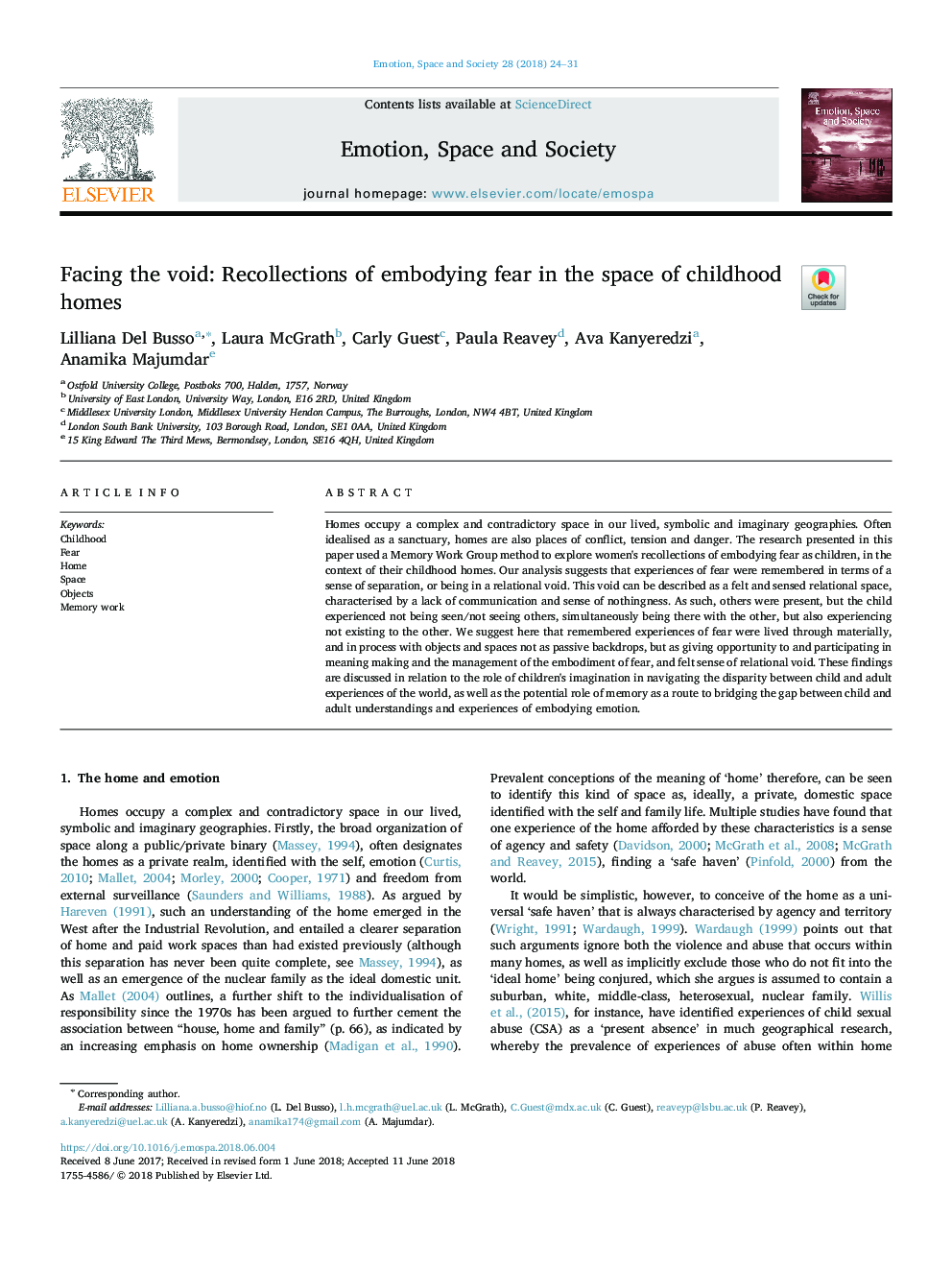| کد مقاله | کد نشریه | سال انتشار | مقاله انگلیسی | نسخه تمام متن |
|---|---|---|---|---|
| 7322743 | 1475619 | 2018 | 8 صفحه PDF | دانلود رایگان |
عنوان انگلیسی مقاله ISI
Facing the void: Recollections of embodying fear in the space of childhood homes
ترجمه فارسی عنوان
در مواجهه با حوصله: خاطرات تلخ در فضای خانه های دوران کودکی
دانلود مقاله + سفارش ترجمه
دانلود مقاله ISI انگلیسی
رایگان برای ایرانیان
کلمات کلیدی
دوران کودکی، ترس خانه فضا، اشیاء، کار حافظه،
ترجمه چکیده
خانه ها فضایی پیچیده و متناقض در جغرافیای زندگی، نمادین و خیالی ما را اشغال می کنند. اغلب به عنوان پناهگاه ایده آل می شوند، خانه ها نیز مکان های درگیری، تنش و خطر هستند. پژوهش حاضر در این مقاله از یک روش کار گروه حافظه برای کشف خاطرات زنان برای تظاهر به ترس به عنوان کودکان در زمینه خانه های دوران کودکی استفاده کرده است. تجزیه و تحلیل ما نشان می دهد که تجارب ترس از لحاظ احساس جدایی و یا داشتن یک خلط ارتباطی به یاد می آیند. این فضای خالی را می توان به عنوان یک فضای ارتباطی احساس و حساس توصیف کرد که با کمبود ارتباط و حس هیچ چیز مشخص می شود. به همین ترتیب، دیگران حضور داشتند، اما کودک با دیدن دیگران دیده نمی شد و همزمان با دیگران در حال دیدن نیست، بلکه در حال تجربه شدن به دیگری نیست. در اینجا پیشنهاد می کنیم تجربیات یاد شده از ترس از طریق مادی و با در نظر گرفتن اشیاء و فضاها، نه به عنوان پس زمینه های منفعل، بلکه به عنوان فرصت و مشارکت در ساختن معنی و مدیریت تجسم ترس و احساس هویت، . این یافته ها در رابطه با نقش تخیل کودکان در مرور اختلاف بین تجارب کودکان و بزرگسالان در جهان و همچنین نقش بالقوه حافظه به عنوان راهی برای برطرف کردن شکاف بین تفاهم و تجارب کودک و تجسم تجسم احساسات .
موضوعات مرتبط
علوم انسانی و اجتماعی
روانشناسی
روانشناسی اجتماعی
چکیده انگلیسی
Homes occupy a complex and contradictory space in our lived, symbolic and imaginary geographies. Often idealised as a sanctuary, homes are also places of conflict, tension and danger. The research presented in this paper used a Memory Work Group method to explore women's recollections of embodying fear as children, in the context of their childhood homes. Our analysis suggests that experiences of fear were remembered in terms of a sense of separation, or being in a relational void. This void can be described as a felt and sensed relational space, characterised by a lack of communication and sense of nothingness. As such, others were present, but the child experienced not being seen/not seeing others, simultaneously being there with the other, but also experiencing not existing to the other. We suggest here that remembered experiences of fear were lived through materially, and in process with objects and spaces not as passive backdrops, but as giving opportunity to and participating in meaning making and the management of the embodiment of fear, and felt sense of relational void. These findings are discussed in relation to the role of children's imagination in navigating the disparity between child and adult experiences of the world, as well as the potential role of memory as a route to bridging the gap between child and adult understandings and experiences of embodying emotion.
ناشر
Database: Elsevier - ScienceDirect (ساینس دایرکت)
Journal: Emotion, Space and Society - Volume 28, August 2018, Pages 24-31
Journal: Emotion, Space and Society - Volume 28, August 2018, Pages 24-31
نویسندگان
Lilliana Del Busso, Laura McGrath, Carly Guest, Paula Reavey, Ava Kanyeredzi, Anamika Majumdar,
